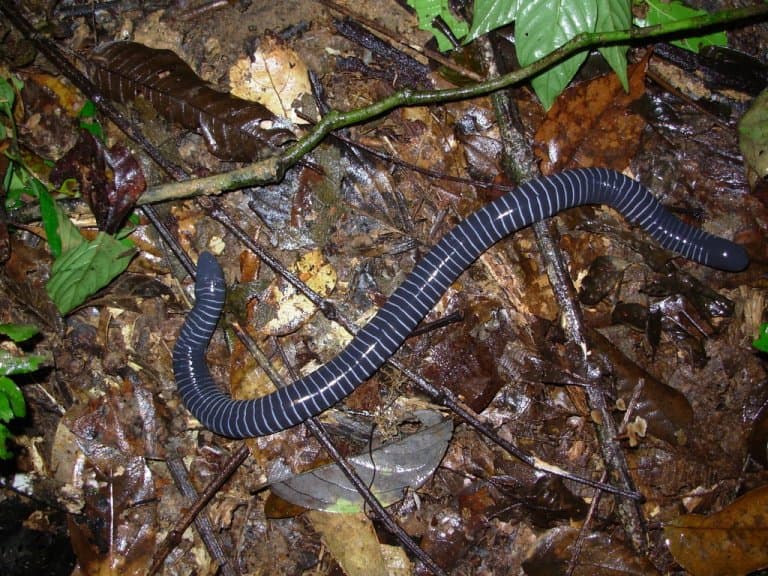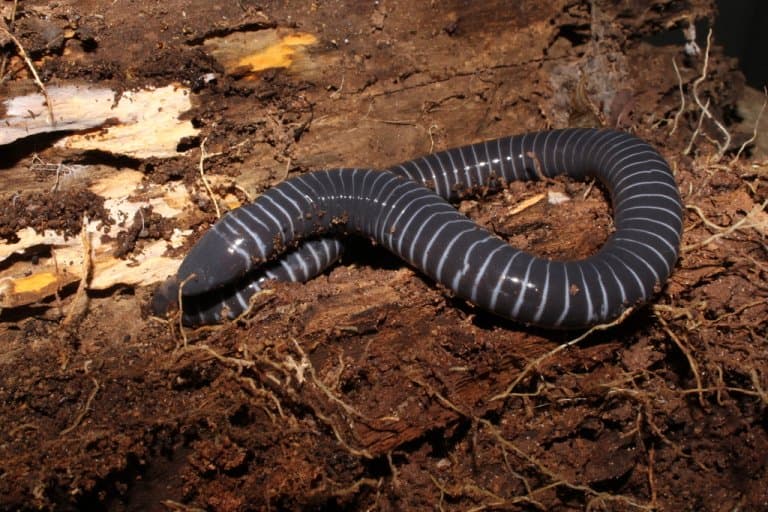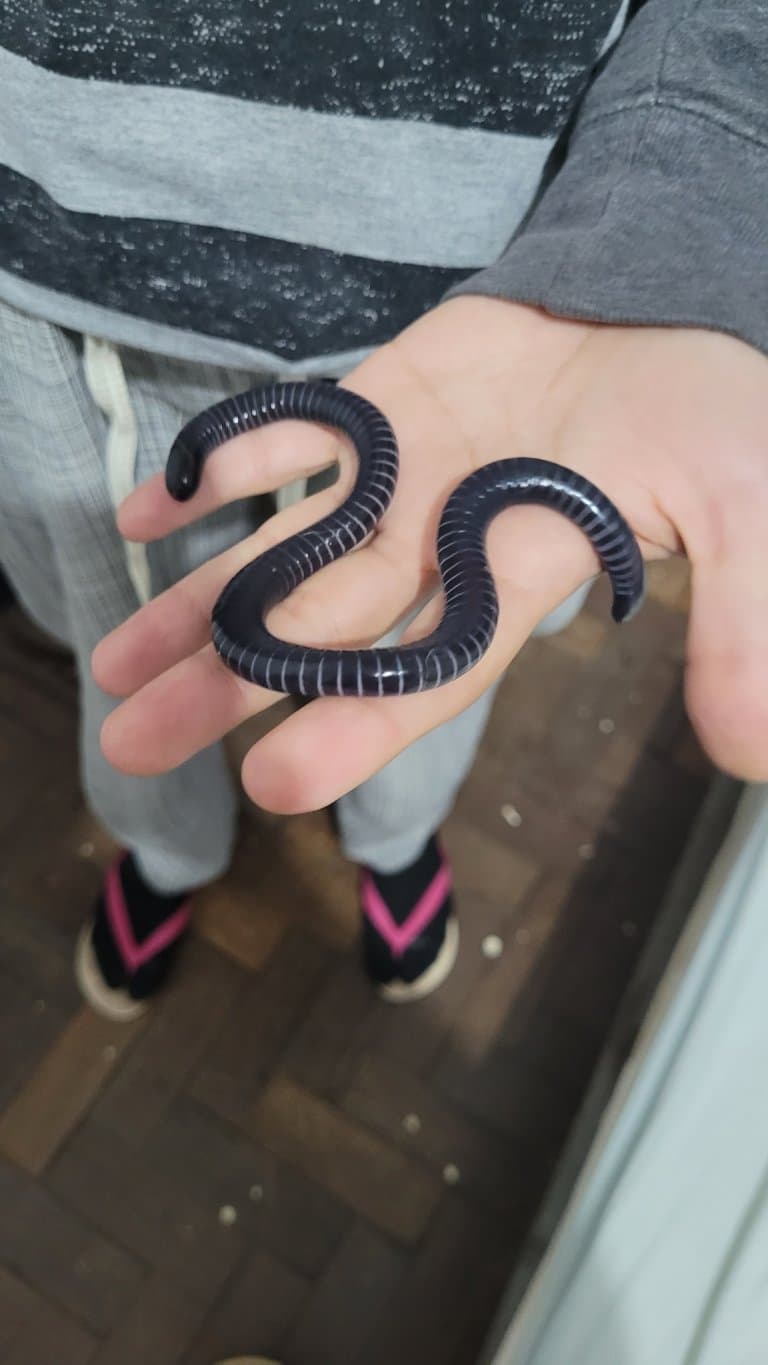Ringed Caecilian Profile
Lots of amphibians can be a bit icky. Some secrete toxins that can have lethal or sometimes hallucinogenic effects. Horn-headed frogs have cannibalistic tadpoles.
The giant Chinese salamander can scream like a baby human. As far as vertebrates go, amphibians are probably the least familiar to us as people. The ringed caecilian is a great reminder of this.
The ringed caecilian (Siphonops annulatus), is a species of caecilian – which are limbless serpentine amphibians, that mostly mind their own business living hidden in the ground.

Ringed Caecilian Facts Overview
| Habitat: | Subtropical, tropical lowland forest; savanna, grassland |
| Location: | South America |
| Lifespan: | Unknown |
| Size: | 45cm (18 inches) long |
| Weight: | Unknown |
| Color: | Blue-black with light bands or rings |
| Diet: | Soil-dwelling invertebrates, such as earthworms, termites, crickets, slugs, and snails |
| Predators: | Burrowing mammals, ants, snakes |
| Top Speed: | Slow |
| No. of Species: |
1 |
| Conservation Status: |
Least concern |
Despite the scientific name (and the bizarre breeding habits you’re about to read about), the word annulatus refers to the rings around this wormlike amphibian. They can grow up to 45cm (18 inches) in length and are a blue-black, slate-gray colour with circular grooves (or rings!) that are cream.
The ringed caecilian is widely distributed in South America, including Brazil, Argentina, Colombia, Bolivia, Ecuador, Peru and other nearby countries.
They inhabit subtropical and tropical forests, savannas and flooded grasslands where they reside in the soil. Their diet is not well known, but they eat soil-dwelling invertebrates, such as earthworms, termites, crickets, slugs, and snails.
They’re great underground, they make a lot of interesting liquids, and they have a very curious way of taking care of their babies.
These relatively unknown animals are possibly unique among amphibians in several ways, and although they’re common, widely distributed and easy to find, there’s still so much left to learn about them.
Interesting Ringed Caecilian Facts
1. They’re adapted to burrowing
All caecilians have limited vision, and can just about tell light from dark with their primitive eyes. Instead, they have numerous characteristics of effective burrowing animals.
Their skull is strong, thick and pointed, and many of its bones are fused for extra rigidity. Their mouths are situated further back, under the head, to avoid getting mud in their teeth, and they have concentric rings of muscle that act like a piston, with one abdominal cylinder moving back and forth inside another.
They can also swim, and have a pair of tentacles on their face, thought to be used for smelling.

2. Babies feed on their mothers skin
There are several ways that brood care presents itself in nature.
It can range from the deleterious effects of a stressed mouse eating her offspring to the doting mother octopus, giving her life to caring for her eggs.
Some birds cough up cottage cheese to feed their young, and mammals secrete a modified version of this ooze from specialised sweat glands, upon which their young enthusiastically suck. Sirenian babies lick this milky substance from their mothers’ armpits, and monotreme mothers just sort of sweat it out of their skin to be lapped up.
Honestly, none of these options sounds particularly appealing, but of all the animals, caecilians might have the most upsetting way to feed their babies.
Caecilian eggs are laid in a small burrow, in which the mother coils herself. They resemble a bunch of amphibious grapes, joined together with gooey strings. When the young hatch, they set to work, all at once, swarming upon the mother and scraping off her skin with 44 spoon-shaped teeth.
This process is called maternal dermatophagy (derm- meaning skin, -phagy- meaning ‘the eating of’), and it’s unusual, to say the least.
The process lasts for a manic seven minutes, during which the mother remains bafflingly meditative, as the biting little worm-like amphibians peel off her skin with frenzied twisting motions and eat it.
This grotesque festival of cannibalism is sometimes repeated in seven-minute bursts every few days, and though it looks traumatic, it’s all part of nature’s plan. Between feeding, the mother regenerates her skin, enriching it with lipids to help her young grow quickly. 1
3. They also feed from her cloaca
If that wasn’t gross enough, one paper describes how “offspring may imbibe liquid exuded from the maternal cloacal opening”. Roughly translated, this means they drink her butt fluids.
This is a behaviour, thankfully, not seen in other amphibians, and manifests as a bizarre ritual in which the mother will lift her back end up, signalling to her young to congregate, which they do; pressing their heads against her opening and lapping up the juice that comes out.
This astounding cocktail of bunions and arse water seems to do the trick. While the mothers are too busy shedding and squirting to feed, the young increase in size by 130% in the first week. Still, the process of parental care lasts an amazing three months from laying the eggs to the offspring going off on their own. 2
4. They can make poison
If you’re going to give caecilian butt juice a go, it’s important you make sure it’s the right fluid before you dive in.
The front end of a caecilian produces a lubricating fluid that helps them ease their way into the earth, the back end, as we mentioned, does produce something of value, but it seems there may be more going on down there than this. Larger, toxin-producing glands are found in large numbers at the tail end of the animal, taking up much of the skin surface.
This poison presumably makes them unpalatable to predators, much like a salamander can be. This chemical defence can be particularly effective when blocking tunnels, and the blunted end of the caecilian has the largest of the poison glands accordingly. 3

5. They may also be venomous
We’ve already identified numerous fluids of varying desirability in this animal, but there’s at least one more worth talking about.
At the base of the caecilian’s teeth, there are even more glands, producing even more weird juices.
It’s not 100% certain yet, but these juices very closely resemble venoms, suggesting that they may be the only extant venomous amphibian, having evolved the adaptation entirely separately from its reptilian analogues. 4
6. We still have so much to learn about them
These wormlike, snakelike creatures are actually neither; they’re more closely related to frogs and salamanders, though distantly linked, even to these other amphibians.
They’ve been around longer than snakes, and so may have developed venom first.
Despite being one of the strangest vertebrates on earth, there’s still not much information available on caecilians in general. The ringed caecilian is only one of around 200 species, distributed all over the Americas, Africa and Asia. Some are burrowers, such as this one, while others can swim.
They’re diverse and weird and may hold countless secrets to an evolutionary past that, had they been cuddlier, we may have already spent money on discovering. 5
Ringed Caecilian Fact-File Summary
Scientific Classification
| Kingdom: | Animalia |
| Phylum: | Chordata |
| Class: | Amphibia |
| Order: | Gymnophiona |
| Family: | Siphonopidae |
| Genus: | Siphonops |
| Species Name: |
Siphonops Annulatus |
Fact Sources & References
- “Siphonops annulatus“, Amphibiaweb.org.
- Carlos Jared (2018), “Life history and reproduction of the neotropical caecilian Siphonops annulatus (Amphibia, Gymnophiona, Siphonopidae), with special emphasis on parental care“, Wiley Online Library.
- Beatriz Mauricio et al. (2021), “Morphology of the Cutaneous Poison and Mucous Glands in Amphibians with Particular Emphasis on Caecilians (Siphonops annulatus)“, Evolution of Venomous and Poisonous Animals).
- Pedro Luiz Mailho-Fontana (2020), “Morphological Evidence for an Oral Venom System in Caecilian Amphibians“, National Library of Medicine.
- Mary-Ann Muffoletto (2020), “Fang-tastic: USU Biologist Reports Amphibians with Snake-like, Venomous Dental Glands“, Utah State University.
